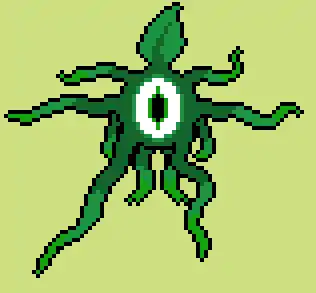Rhylithic (5e Race)
Rhylithic
The man walked - no, shambled, down the street. His stance unnatural and his skin as pale as the moonlight - a stark contrast against the bright green veins that protruded from his body like tattoos. An obtrusive smell trails him, turning the stomach of those he passes.
Physical Description
 |
|---|
| A pre-alpha Rhylithic without a host, created by BadaBomb |
A rhylithic is a small, plant-based being. Their bodies just strong enough to maintain shape, move around and manipulate objects. Rhylithics may be covered in a variety of foliage ranging from bushy to being covered in flowers. Four large vines serve as main appendages to move and manipulate its surroundings, accompanied by several smaller tendrils that seem to sprout from its body at random. A large, singular socket sits at the center of their body, mimicking the appearance of a reptilian eye. This ‘eye’ is actually a collection of light-sensitive receptor cells, allowing the rhylithic to perceive the world around itself. They are incapable of speech without a host, instead emitting small, low pitched sounds to one another through vibration. Despite the idea that their rather unique physique may make them stand out in a crowd, you will rarely see a rhylithic as described above.
Rhylithics are essentially parasites, using the bodies of humanoids as a means of traversing large distances and gaining nutrition. Due to their inherent lack of strength, they rarely manage to kill a host to infest, instead opting to use fresh corpses. Their flexible bodily structure allows them to enter the body through a small hole they make just below the ribs, where it will settle in the chest cavity. Their four large vines insert into the host’s limbs, manipulating the tendons to move forward. Similarly, small tendrils manipulate finer of the body like the vocal cords. If the body wasn’t already in a state of decay, it will turn pale as its blood is drained, with its veins slowly turning green as the rhylithic replaces them with its tendrils.
The average rhylithic requires 2-4 hosts worth of nutrients to develop fully. A healthy, fresh host contains more nutrients than a week old corpse. Once the rhylithic has gained enough nutrients, they shed their host for the last time and evolve into an alpha rhylithic. These alpha rhylithics have a stronger structure, appearing in the shape of a muscular humanoid. Their core develops, often turning into a large flower or the beak of a carnivorous plant, with their eye still at the center. The time they have spent in their hosts has allowed them to fine-tune their vibrations, giving them the ability to speak basic common. The alpha rhylithic cannot revert back to its previous form.
History
Rhylithics are known by upper races to be one of the oldest living races, but one of the most concealed. Rhylithics rarely communicate outside their own race. The ones who do are known to be more intelligent, and less isolated. Rhylithics transmit their history orally, but the Rhylithics who have become urbanized will write down their history. However, due to the history normally being orally transmitted, some details over time have become forgotten.
Rhylithics are said to have been a creation due to cursed blood upon a forest, which caused for rapid mutation. After their birth, they discovered by harvesting the nutrients of corpses would allow them to transform into stronger beings. They became strong hunters with their affinity to learn and apply information, such as any other sentient race. Through time, they interacted with other races, which lead to some Rhylithics joining urban areas and becoming more scholarly than their rural counterparts. This lead to a split within their race, Rural vs Urban Rhylithics. Neither side has a large advantage other than how they will live their lives.
Society
Rhylithics migrate often, in search of new corpses as hosts. Rhylithics do not form large groups, as they do not need mates. Rhylithics are asexual, and produce up to 6 offspring in their lifespan. In their final reproduction, they will die. Due to this, they only migrate in groups of 3-5 Rhylithics, and do not grow more afterwards. They form groups in order to protect each other, as they can easily be defeated in their pre-alpha form. Rhylithics who travel alone will attempt to blend in with society or having a guardian help them eventually upgrade into their Alpha form. Rhylithics will attempt to stay isolated if alone, and will attempt to use any corpse as a host in order to cultivate enough nutrients to upgrade. After upgrading into an Alpha, they will settle and create a den will limited members in order to prepare for reproduction. They do this as soon as possible, and leave their den and hide it from outside view. They then reproduce more times over the course of their life-time, until their final reproduction.
Rhylithics who have joined society begin by usually infesting themselves into a medium to large animal body and only use animal bodies until they are ready to upgrade into their Alpha form. They will be taken care of by a guardian, who would ensure their safety as they gain proper nutrients. The guardian will usually be a member of the same society the Urban Rhylithic will join with. The reasons for someone to take care of a Rhylithic would depend on that person. Urban Rhylithics will prefer craftsmen or scholars so they can learn from them. They will usually join craftsmen or scholars as an assistant when they have upgraded into their Alpha form. They too, as their rural counterparts will now search for a purpose, and will usually not reproduce until their later life in order to prevent any form of early death. Many of the rural Rhylithics consider the urbanized Rhylithics to be traitors, but will not attack them. Instead, they will refuse the urbanized Rhylithics entry into their packs and call them "Soft-roots".
Rhylithic Names
Rhylithics will take on very simple names, usually based around nature or simple observations of life. They are sometimes spelt differently than they are normally in order to ensure contrast between the name and object. Urban Rhylithics may take on more proper names given to them by someone else.
Rural: Leaf, Skye, Rok, Trii, Winter, Summer, Cane
Urban: Drypos, Vonedes, Reignberck, Raisenin, Sonin
Rhylithic Traits
An infesting race that will eventually transform into a gruesome form.
Ability Score Increase. Your Constitution score increases by 2
Age. Pre-Alpha Rhylithics will only live up to 20 years, Alpha Rhylithics will live up to 200 years.
Alignment. Due to how Rhylithics must use corpses as hosts in order to cultivate nutrients, they usually take a chaotic stance
Size. The size of a Rhylithic will depend on their host, but without a host they are small. After upgrading to an Alpha Rhylithic, you become medium.
Speed. Your base walking speed will be equivalent to your host's speed, without one it is 30 feet.
Darkvision. You can see in dim light within 60 feet of you as if it were bright light, and in darkness as if it were dim light. You can't discern color in darkness, only shades of gray.
Host Body. Rhylithics will take a host body from playable races. They will only gain benefits from one of the physical traits from that body, such as Tiefling's fire resistance, but will not gain any traits if they are magical or mental such as an elfs Fey Ancestry or a gnomes Gnome Cunning. A physical trait is determined by what the body may provide, such as skin, blood, or organs. Soul or mind traits cannot be given to a Rhylithic, as the Rhylithic has no need for either of them. The host body will become their shelter until it is damaged beyond repair or it decomposes. If the host body is damaged beyond repair or killed in combat, you will instead exit the body with health equivalent to your Constitution modifier. In order to gain a new body, you must find a body, ensure it's death, and enter the body through an opening. This is done over the course of a short rest.
Dead Host. Rhylithic's host body will decompose over time, which will lead to the body weakening. Every time a Rhylithic levels up, they must make a Constitution saving throw of 8 or above to ensure the body does not fall apart. If they pass, the saving throw minimum will increase by 2 for every level up. If they fail, they must find a new body as the old body has been too decomposed.
Vine Veins. Your vines replace the veins within your host body, which strengthens the body and allows for better contentment of the body. Due to this, you have resistance on loosing limbs, and if you were to loose one, you may find a replacement from another corpse.
Languages. You can speak, read and write Common, Sylvan.
Subrace. Upgrade into an Alpha Rhylithic at level 10.
After cultivating enough nutrients, a Rhylithic may transform into an Alpha Rhylithic. This provides them with new traits as seen below, and all previous traits are null.
Alpha Rhylithic
Ability Score Increase. You may add one point to any stat.
Cultivated Body. Due to the long process of harvesting nutrients from corpses, you gain a new subrace which is suited to your new body.
Vine Arms. You do not grow arms, but instead have vines in their place. They may morph into arms for role-play purposes. In combat, they act as weapons being able to do 1d8 slash damage, as if they were a whip. The amount of vines vary from 4-12, ranging from thickness to thinness. If one of your limbs are destroyed, you may regrow one missing limb per long rest.
Carnivorous Aftertaste. You do not preform Photosynthesis for food/fuel, unlike your plant brothern. You do not need to drink, but you need to consume meat in order to survive. Any form of meat is acceptable, ranging from animals to sentient races. In combat, you may eat a corpse, healing yourself for 1d4 + your Constitution modifier.
Plant Body. Your new body has now turned you into a humanoid and plant creature type. However, you are vulnerable to fire damage but resistant to radiant damage.
Nightblood Rhylihtic
Adaptive Scales. Your new body has grown a form of scales upon your vines and leaves, allowing to you enter a form of camouflage. When out of combat or standing still, you gain advantage on all sneak rolls made and cannot be seen by the normal eye.
Malicious Mimic. You may mimic a voice or sound you've heard, having to pass a Wisdom check to accurately mimic it. Anyone who hears your mimicry may roll their own Wisdom check to determine if they believe the mimicry or not.
Dragonblood Rhylithic
Dragon Adaptation. Your new body has grown a new organ, which lets you use breath weapon in a different form. You spew an elemental breath attack, chosen from the Draconic Ancestry Table, doing 2d6 damage. You may only use this twice per combat, afterwards you must do a long rest to recharge.
Scaled Leaves. Your plant-flesh has grown a form of scales, allowing you to gain resistance to the form of element you've chosen for your breath attack.
Mixed Blood Rhylithic
Survival Instinct. Due to the different types of blood you've absorbed, one message became clear in your mind, to survive. You gain proficiency in the Survival skill.
Animal Rage. Once per combat, you may let out a booming howl/screech in an 2d4 + Proficiency Bonus area around you. Anyone caught in the blast will have to make a Constitution saving throw or they will become frightened. You recharge this attack after a short rest.
Back to Main Page → 5e Homebrew → Races


